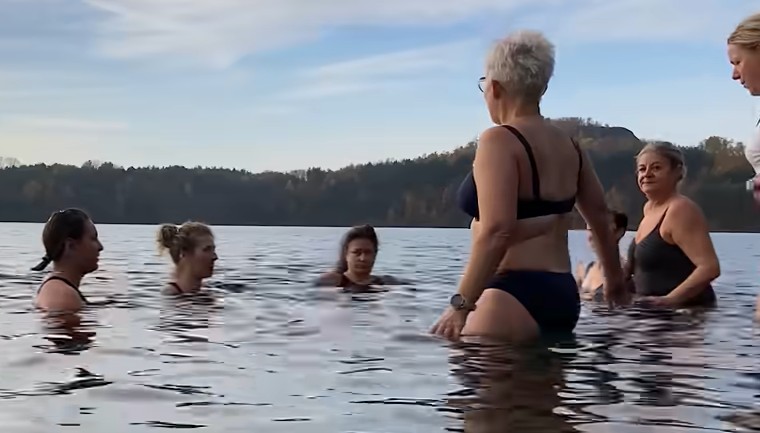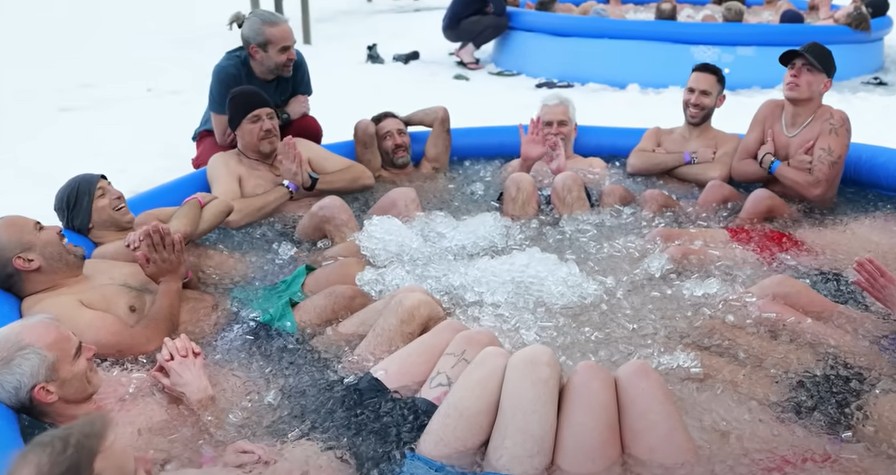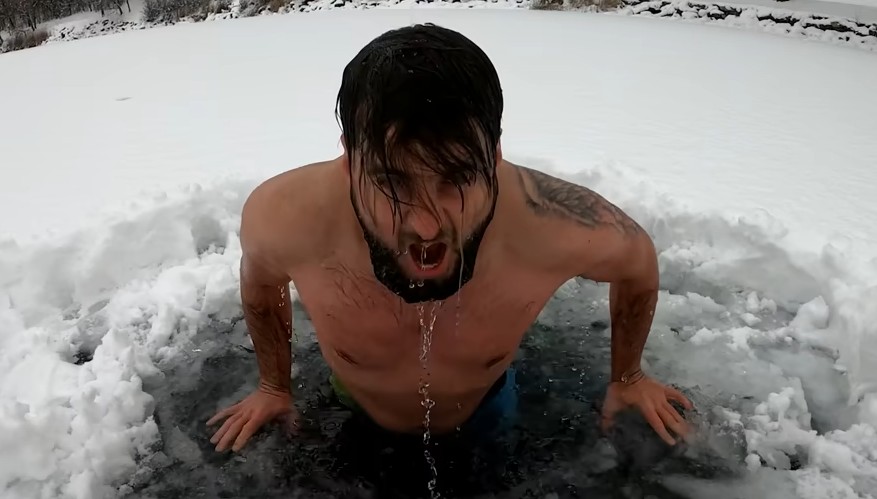Need help?
Unsure whether you need a bath or a plunge, portable or fixed, chiller or iced? Check out Sasha’s cold plunge vs ice bath article to answer all and get clarity on your cold immersion needs.

As a sports medicine pro and self-experimenter, I’ve always been intrigued by unconventional health practices. Cold plunge benefits caught my attention years ago, and I decided to explore it’s potential firsthand.
What began as a skeptical foray into icy waters has transformed into a fascinating scientific exploration and personal growth experience.
Contents
- 1 The First Plunge
- 2 The Science Behind Cold Plunge Therapy
- 3 Overcoming the Mental Hurdle
- 4 Implementing Cold Plunge Therapy
- 5 Common Pitfalls and How to Avoid Them
- 6 Adapting Cold Plunge Therapy
- 7 Building on the Basics
- 8 Exercises to Enhance Your Cold Plunge Experience
- 9 The Transformative Importance of Cold Plunge Therapy
- 10 Key Takeaways:
- 11 People Also Asked
- 11.1 What temperature should water be for a cold plunge?
- 11.2 How long should you stay in a cold plunge?
- 11.3 Can cold plunges help with weight loss?
- 11.4 Are cold plunges safe for everyone?
- 11.5 How often should you do cold plunges?
- 11.6 Can cold plunges improve athletic performance?
- 11.7 Do cold plunges boost the immune system?
- 11.8 What’s the difference between ice baths and cold plunges?
- 11.9 Can cold plunges help with depression or anxiety?
- 11.10 How do I start cold plunge therapy at home?
The First Plunge
My initial cold plunge, into a portable ice bath in my yard, was nothing short of shocking. Lowering myself into 50°F (10°C) water, I questioned my sanity.
But as I focused on controlling my breath and endured the recommended two minutes, something unexpected happened. Upon emerging, I felt an incredible surge of energy and alertness.
This experience sparked my curiosity and led me to take a closer look into the physiological effects of cold water immersion.
The Science Behind Cold Plunge Therapy
Vasoconstriction and Improved Circulation
One of the most immediate effects of cold water immersion is vasoconstriction – the narrowing of blood vessels. While this might sound concerning, it’s actually a beneficial stress on the body.
As you exit the cold water, your blood vessels rapidly dilate, improving circulation throughout your body.
This process, when repeated regularly, can lead to improved cardiovascular health over time.
Hormonal Response
Cold water immersion triggers the release of norepinephrine, a hormone and neurotransmitter that can boost focus and attention. In my personal experience, I’ve noticed significantly improved mental clarity after a cold plunge.
This makes it an excellent way to start the day or refresh my mind during a busy afternoon.
Inflammation and Recovery
As a sports medicine physician, I often encounter inflammation-related issues in my patients. Studies have shown that cold water immersion can reduce markers of inflammation in the body.
I’ve observed this effect in athletes who use cold plunges as part of their recovery routine – they often report reduced muscle soreness and faster recovery times.
However, remember that the relationship between cold plunges and muscle recovery isn’t straightforward. While cold water immersion can be useful for reducing acute inflammation and soreness, some research suggests that it might impair muscle growth if used immediately after strength training.
This underscores the importance of timing and context when recommending cold plunge therapy.
Mental Health and Stress Reduction
One of the most surprising cold plunge benefits I’ve experienced personally is the impact on my stress levels and overall mood. Cold water immersion stimulates the vagus nerve, which plays a crucial role in our parasympathetic nervous system – the system responsible for our ‘rest and digest’ state.
Regular cold plunges have helped me manage stress more effectively and have even improved my sleep quality.
Metabolic Boost and Weight Management
Cold plunges can have significant effects on metabolism. Exposure to cold water activates brown adipose tissue, often called ‘good fat,’ which burns calories to generate heat.
This process, known as thermogenesis, can boost your metabolism for hours after your plunge.
This aspect of cold plunge therapy is particularly interesting in the context of weight management and metabolic health.
Overcoming the Mental Hurdle
Cold plunges aren’t exactly comfortable, especially at first. However, over time, your body adapts.
This process, known as cold adaptation, makes the experience more tolerable and enhances the benefits.
I’ve experienced this adaptation firsthand. What started as a teeth-chattering, breath-stealing ordeal has become an invigorating part of my routine that I actually look forward to.
The mental resilience I’ve developed through this practice has spilled over into other areas of my life.
Implementing Cold Plunge Therapy
If you’re interested in trying cold plunge therapy, here’s a comprehensive guide to get you started:
1. Start Gradually
Begin with cool showers, slowly decreasing the temperature over time. This allows your body to acclimate to colder temperatures without the shock of immediate immersion in ice-cold water.
Start by ending your regular shower with 30 seconds of cool water, gradually increasing the duration and decreasing the temperature over several weeks.
2. Set a Timer
When you’re ready to try full immersion, start with 30 seconds to 1 minute, gradually increasing to 2-3 minutes. Using a timer helps you stay focused and ensures you don’t overexpose yourself to the cold.
Remember, longer isn’t always better – the benefits of cold plunge therapy can be achieved in relatively short durations.
3. Focus on Breathing
Use deep, controlled breaths to manage the initial shock. When you first enter cold water, your body’s natural response is to gasp and breathe rapidly.
By consciously controlling your breath, you can override this response and stay calm.
Practice diaphragmatic breathing: inhale deeply through your nose for a count of four, hold for a count of four, then exhale slowly through your mouth for a count of six.
4. Warm Up Naturally
After your plunge, let your body warm up on it’s own to maximize the benefits. Resist the urge to jump into a hot shower immediately.
Instead, dry off, put on warm clothes, and engage in light movement to encourage blood flow.
This natural rewarming process is part of what stimulates the beneficial physiological responses we’re aiming for.
5. Be Consistent
Aim for 2-3 sessions per week to see the best results. Consistency is a critical factor in gaining cold plunge benefits.
Regular exposure allows your body to adapt and enhances the long-term benefits.
Consider incorporating cold plunges into your routine at the same times each week to help establish the habit.
Common Pitfalls and How to Avoid Them
While cold plunge therapy can be incredibly beneficial, there are some potential pitfalls to be aware of:
1. Overexposure
Staying in too long can lead to hypothermia. Always stick to recommended time limits, especially when you’re just starting out.
If you start to feel numbness or intense discomfort, it’s time to get out.
Remember, the goal is to challenge your body, not endanger it.
2. Improper Timing
Avoid cold plunges immediately after intense workouts if muscle growth is your goal. While cold therapy can be great for recovery, some studies suggest it may interfere with the muscle-building process if used too soon after strength training.
Consider waiting at least an hour after your workout before doing a cold plunge.
3. Ignoring Your Body
If you feel extreme discomfort or pain, exit the water immediately. While some discomfort is normal and expected, sharp pain or feelings of panic are signs that you should end the session.
Listen to your body and respect it’s limits.
4. Neglecting Safety
Never plunge alone, especially when you’re just starting out. Having someone nearby ensures help is available if needed. Also, make sure your plunge area is safe – non-slip surfaces, easy entry and exit points, and a way to quickly warm up if necessary are all important considerations.

Adapting Cold Plunge Therapy
Cold plunge therapy can be adapted to various scenarios:
For Athletes
Use it as part of your recovery routine, but time it wisely. Cold plunges can be particularly beneficial after endurance activities or high-intensity interval training.
However, as mentioned earlier, be cautious about using cold therapy immediately after strength training sessions.
For Stress Management
Incorporate it into your morning routine to start the day refreshed. A morning cold plunge can set a positive tone for the day, increasing alertness and reducing stress levels. Consider following your plunge with meditation or journaling to enhance the stress-reducing benefits.
For Weight Management
Combine it with a healthy diet and exercise regimen. While cold plunges can boost metabolism, they’re most effective when part of a comprehensive approach to health and fitness.
Use the energy boost from your plunge to fuel a workout or make healthier food choices throughout the day.
For Mental Health
Use it as a tool for building resilience and improving mood. The challenge of regular cold exposure can help build mental toughness that translates to other areas of life.
Many people, myself included, report improved mood and reduced symptoms of anxiety and depression with regular cold plunge practice.
Building on the Basics
As you become more comfortable with cold plunges, you can explore more advanced techniques:
Contrast Therapy
Alternating between hot and cold exposure can enhance circulation and provide a unique set of benefits. Try alternating between a hot sauna or bath and your cold plunge, spending about 3-5 minutes in each.
Repeat this cycle 3-4 times, always ending with cold exposure.
Breath Work
Incorporating specific breathing techniques can enhance cold plunge benefits. The Wim Hof Method, which combines cold exposure with specialized breathing techniques, has gained popularity for it’s potential to boost immune function and mental resilience.
Longer Durations
Gradually increasing your time in the cold water can lead to greater cold adaptation and potentially enhanced benefits. However, always increase duration slowly and listen to your body.
Even experienced practitioners rarely need to exceed 5-10 minutes of cold exposure to reap the benefits.
Colder Temperatures
Slowly decreasing the water temperature as your tolerance improves can intensify the effects of your cold plunges. However, be cautious and decrease temperature gradually.
Water temperatures below 50°F (10°C) should only be attempted by experienced practitioners under supervised conditions.
Exercises to Enhance Your Cold Plunge Experience
Practice Box Breathing Before Your Plunge
Box breathing, also known as square breathing, can help prepare you mentally for the cold plunge. Inhale for a count of four, hold for four, exhale for four, and hold for four.
Repeat this cycle for 1-2 minutes before your plunge to calm your nervous system and focus your mind.
Try Body Scanning During the Plunge
Body scanning is a mindfulness technique that involves focusing your attention on different parts of your body in sequence. During your cold plunge, start at your toes and slowly move your attention up through your body, noticing sensations without judgment.
This can help you stay present and manage the discomfort of the cold.
Set an Intention Before Each Session
Before each cold plunge, take a moment to set an intention. This could be related to a specific benefit you’re hoping to achieve (like stress reduction or improved recovery), or it could be a broader intention for your day or week.
Having a clear purpose can help motivate you and enhance the mental benefits of your practice.
Keep a Journal to Track Your Progress
Maintaining a journal of your cold plunge experiences can be incredibly valuable. Note the duration and temperature of each plunge, how you felt before and after, and any changes you notice in your overall health and well-being.
This can help you track your progress, identify patterns, and stay motivated.
The Transformative Importance of Cold Plunge Therapy
My journey with cold plunge therapy has been nothing short of transformative. From improved recovery times for my athletes to enhanced mental clarity and stress resilience in my own life, cold plunge benefits have been substantial.
Cold water immersion, when used appropriately, can be a powerful tool in your health and wellness toolkit.
As I continue to research and experience cold plunge benefits, I’m excited about the potential applications in both sports medicine and general health. The simplicity of this practice – essentially, immersing oneself in cold water – belies it’s profound physiological and psychological impacts.
Key Takeaways:
- Cold plunge therapy can improve circulation, reduce inflammation, and boost mental clarity.
- Gradual adaptation is key to reaping the full benefits.
- Proper timing and technique are crucial for maximizing benefits and minimizing risks.
- Cold plunges can be a powerful tool for stress management and mental resilience.
- As with any health practice, individual responses may vary, and it’s important to listen to your body.
People Also Asked
What temperature should water be for a cold plunge?
Ideal cold plunge temperatures typically range from 50-59°F (10-15°C). Beginners might start at the warmer end of this range and gradually work towards colder temperatures.
How long should you stay in a cold plunge?
For beginners, 30 seconds to 2 minutes is a good starting point. More experienced practitioners might stay in for 3-5 minutes.
Always listen to your body and exit if you feel extreme discomfort.
Can cold plunges help with weight loss?
Cold plunges can boost metabolism and activate brown fat, potentially aiding in weight management when combined with a healthy diet and exercise regimen.
Are cold plunges safe for everyone?
While generally safe for healthy individuals, those with certain medical conditions (like heart problems or high blood pressure) should ask a doctor before trying cold plunge therapy.
How often should you do cold plunges?
For most people, 2-3 times per week is enough to experience benefits. Some practitioners do daily cold exposure, but this isn’t necessary for everyone.
Can cold plunges improve athletic performance?
Cold plunges can help with recovery and potentially improve endurance, but timing is crucial. Avoid cold exposure immediately after strength training if muscle growth is your goal.
Do cold plunges boost the immune system?
Some research suggests that regular cold exposure can enhance immune function, but more studies are needed to fully understand this relationship.
What’s the difference between ice baths and cold plunges?
Ice baths typically involve colder temperatures (usually below 50°F/10°C) and are often used specifically for athletic recovery. Cold plunges can be slightly warmer and are used for a broader range of health benefits. A full article on the many terms and often confusing jargon can be found here<<
Can cold plunges help with depression or anxiety?
Some people report improved mood and reduced symptoms of depression and anxiety with regular cold plunge practice. The shock of cold water may stimulate the production of mood-boosting neurotransmitters.
How do I start cold plunge therapy at home?
You can start with cold showers, gradually decreasing the temperature over time. For full immersion, a bathtub filled with cold water (you can add ice to lower the temperature) can work.
Always prioritize safety and start with short durations.
This website may contain affiliate links. As an affiliate, we may earn a commission from qualifying purchases at no additional cost to you.

